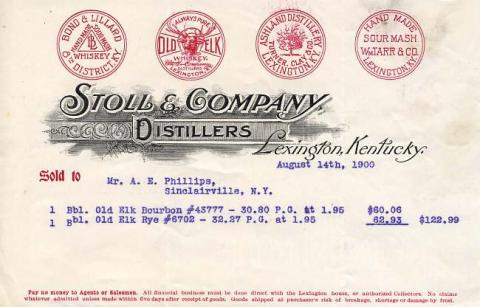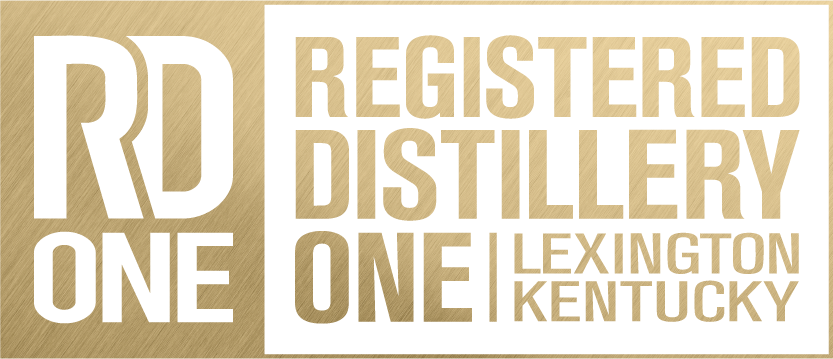
In 1865, the Ashland Distillery was established, the first to obtain a federally registered distillery license, and was assigned RD#1. Located on Manchester Street at the city limits of Lexington, KY, today, the remains of the original distillery can be found at what is now the entrance to Lexington's Distillery District. In 2021, RD1 Distillery was reborn with the mission to bring a portfolio that inherits the storied history of the distillery but also a quality worth of Lexington's legendary whiskey heritage. Below is a detailed history of our Distillery and the personal stories of the key figures in our legacy.
1865
Turner, Clay, & Company - comprised of Horace H. Turner, Samuel M. Clay, and Thomas D. Mitchell - established the Ashland Distillery. All three gentlemen were prominent merchants in Lexington.
1866
The property was purchased on November 12 for $10,000. The distillery was situated on 11 acres of land on Manchester Street (also known as Old Frankfort Pike) near Cox Street at the city limits, approximately 80 yards from the former Louisville, Cincinnati & Lexington Railroad just 2,500 feet east of the Henry Clay-James Pepper Distillery. The site was previously home to lead works and a pork processing facility. Ashland Distillery was the first to obtain a federally registered distillery license in Lexington and was assigned RD #1. Their products were marketed as "Ashland Whiskey" and advertised as 'Manufacturers of Pure Copper Distilled Whiskey, at Ashland Distillery, on Manchester, west of Cox.' The firm produced about 30 barrels of whiskey per day from October 1868-January 1869. The partners also completed a bonded warehouse in December 1868, and one said to be 'fireproof.'
1871
Following years of financial hardship and Turner's death, William Tarr of Bourbon County and Thomas J. Megibben of Harrison County acquired the Ashland Distillery for $115,000 and restarted whiskey production. Tarr was a prominent land speculator, and Megibben was a successful dry goods merchant; both men were also distillers, entering the business before the Civil War. Principals in the Company also included Clay and J.M. Kimbrough. They continued to produce Ashland Whiskey and introduced a new brand, initially called "Wm. Tarr Whiskey" and later known as "Old Tarr Whiskey." Both brands distilled rye and bourbon versions.
1875
Clay established a whiskey brokerage and distribution company in Lexington, with offices located at 11 West Water Street; Clay was originally from Paris (Bourbon County) and associates with Megibben.
1879
In May, the distillery was ravaged by a fire, and the structures burned quickly and out of control. Distilleries were always prone to fires, given their wooden construction and the volatile nature of their products. This disaster (and the Phoenix Hotel fire later in the month) forced the city fathers of Lexington to establish waterworks that provided a year-round supply of water to fight fires and thereby lower insurance rates. Thus, the Lexington Fire Department was born. In September, the distillery was reorganized as Wm. Tarr & Company. Tarr remained the President with 40% ownership, Megibben became a director and retained another 40%. The remaining 20% was split between Clay (by then the company salesman) and Joseph M. Kimbrough, the plant manager and Megibben's son-in-law. Under this arrangement, a new distillery and warehouses were rebuilt on the same site at the cost of $75,000 ($1.8 million today), this time in brick with fireproof slate or metal roofs.
Tarr's distillery was state-of-the-art, with floor space covering 25,000 square feet and including 14 fermentation tubs, each with a capacity of 9,500 gallons. The primary mash tub held 10,000 gallons, with 400 smaller mash tubs of 101 gallons each. Three brick, metal-roofed warehouses contained a storage capacity of 68,000 square feet, or more than an acre and a half. The firm had an annual production capacity of 6,000 barrels. The new plant mashed roughly 984 bushels of corn, rye, and malted barley per day. Corn was purchased from local farmers - generating an estimated $30,000 in sales for the farmers - but rye and barley malt came by rail. The slop was used to fatten about 500 cattle to market weight each year, housed in a large cattle shed covering one-third of an acre beside Town Branch.
Rather than draw water from Town Branch, the Company leased springwater from Ater Spring, located approximately 200 yards from the distillery. The lease was for 25 years, with an annual payment of $100. The distillery constructed a stone wall around the spring and covered it with a small house to better protect the water; Tarr later purchased the spring outright. Pumps supplied 200,000 gallons of fresh limestone water (at a constant temperature of 57 degrees Fahrenheit) daily through a system of pipes. The managers at Pepper or the Tarr distillery chose to use Town Branch water, but the reason isn't exactly clear. The distillers either knew that its flow was seasonally unreliable or that the Town Branch was heavily polluted from street runoff, garbage, privies waste, stables, or other industries.
1880
Clay purchased the Paris Distillery in Paris, Kentucky, and produced a sour mash whiskey called "Sam Clay Bourbon." In 1882, the plant produced 40 barrels per day and had more than 15,000 barrels in bonded storage. Megibben operated the Paris Distillery from 1884-1890. In 1901, Clay sold the distillery to the Kentucky Distilling & Warehouse Co., widely known as "The Whiskey Trust."
1881
The distillery added a cooper shop to the north (downstream) that produced 50 barrels per week with 20 employees. The Louisville, Cincinnati & Lexington Railroad's yard (later Louisville & Nashville Railroad) was adjacent to the shop, with a siding running into the distillery.
1882
35 workers produced about 45 barrels of whiskey daily. Barrels of whiskey were transported by rail. The distillery produced the "Ashland", a sweet mash, and "Wm. Tarr", a sour mash (later known as "Old Tarr") brand of whiskey. The sweet mash was held for 92 hours and the sour mash for 96 hours. Annual whiskey production grew to 5,500 barrels annually, manufacturing about equal quantities of sweet and sour mash whiskey, valued at $150,000 ($3.1 million today). 18,000 barrels were kept in bonded storage, and Old Tarr was advertised as 'Always True.'
1884
Clay left the Wm. Tarr partnership over the disputed sale of the Kentucky Union Railroad, Tarr's other business venture with Megibben. Clay's share was obtained by Thompson Tarr, William's eldest son, and distributions of the distillery's products were assumed by J. A. Lail & Company. From 1886 to 1890, the Company leased the rear portion of their Bonded Warehouse #1 to the firm Derby & Day, whiskey brokers of Louisville. Behind the scenes, the Kentucky Union Railroad Company was wreaking havoc on Tarr's fortunes, and by 1890 Megibben had died. Tarr purchased his interest and appointed Thompson as company vice president. Now the Tarrs owned the distillery almost in its entirety. The firm of J. A. Lail & Company assumed the distribution for the Wm. Tarr & Company.
1892
After the deaths of Megibben and Kimbrough in 1890, Tarr purchased their interests and continued as President, while his son was elected Vice President, and J. B. Huffman was selected Secretary. Distribution was also shifted to R. S. Strader & Company. Tarr purchased the nearby Lexington Distillery to acquire 10,000 barrels of bourbon in storage. He then demolished the plant and moved the whiskey to his own warehouses.
1897
Having been significantly weakened financially by the railroad, Tarr soon defaulted on numerous loans. To stay afloat, Tarr invited into the management members of the Stoll family of Lexington, who controlled several distilleries in central Kentucky.
On January 1, Tarr issued $50,000 in the first mortgage, and gold bonds as a last-ditch effort to save his distillery. Four months later, in May 1897, the end came. Tarr declared bankruptcy, and all assets were assigned to James S. Stoll and Richard P. Stoll as receivers. The aftereffects of the Panic of 1893 and depression in the whiskey industry only compounded Tarr's defaulted notes to family and friends. Tarr's personal assets included 2,000 acres of farmland in Bourbon County, commercial real estate in Paris, the Ater Spring in Lexington, and several lots in Superior City, Michigan. The distillery assets included 10,000 barrels in bond of "Wm. Tarr" bourbon. Liabilities included ordinary payables and the first mortgage bonds.
1899
Wm. Tarr & Company was auctioned at a Master Commissioner's sale to Leonard G. Cox, of Graves, Cox & Co., for $60,001. He was bidding against G. G. White (distiller of Paris), Lewis LeBus (of Cincinnati), and Squire Basset (of the Fayette National Bank of Lexington). These three were the more significant creditors of the Company. Cox turned out to be a straw bidder for Charles H. Stoll and The Whiskey Trust. The Stoll brothers liquidated the distillery, while at the same time, they were involved with the formation of The Whiskey Trust.
After the Stoll family's Commonwealth Distillery sale in 1899, James S. Stoll operated his brokerage business as Stoll & Company (as successor to Stoll, Vannatta & Company). "Old Elk" was the Company's proprietary brand of whiskey. He also controlled the market in "Old Tarr" and "Bond & Lillard" whiskies, owning large numbers of warehouse receipts for these two brands. This whiskey was stored in the bonded warehouses at the former Wm. Tarr Distillery and Mr. Stoll marketed these brands.
1902
In December, Stoll & Company was incorporated. Later that month, the former Wm. Tarr Distillery and the Bond & Lillard Distillery - located in Anderson County - were sold by The Whiskey Trust to Stoll & Company. As a result, the Company now controlled the "Bond & Lillard," "Old Tarr," "Ashland," and "Old Elk" brands.
1905
In March, Stoll & Company purchased the Belle of Nelson and E. L. Miles & Co. Distilleries in Nelson County, Kentucky. The purchase price was $486,655.32 for both. They also obtained 25,000 barrels of bonded whiskey with the deal. With these two additional distilleries, Stoll & Company became the largest distilling conglomerate in Kentucky, with four operating distilleries. They also picked up two additional brands - "Belle of Nelson" and "E. L. Miles" - a total of six brands of whiskies.
1907
The Stoll family consolidated their wholesaling whiskey businesses - Stoll & Company and Stoll, Hamilton & Company - into Stoll & Company Inc. The new firm distilled and marketed seven brands: "Ashland," "Old Tarr," "Old Elk," "Bond & Lillard," "Belle of Nelson," "E. L. Miles & Co.," and "New Hope." They engaged sales representatives to cover the entire United States. Their main office and warehouse were retained in Lexington, while the firm had six other warehouses around the state. They employed over 100 workers.
1908
After the deaths of Richard P. Stoll (in 1903) and James S. Stoll (in 1908), the Stoll distilling interests were consolidated into The Whiskey Trust. The former Wm. Tarr Distillery plant was dismantled. Operations continued under the name Stoll & Company until Prohibition in 1919.
1909
In March, Maurice Greenbaum of the S. J. Greenbaum Company of Louisville purchased the entire whiskey inventory in the Wm. Tarr warehouses. Greenbaum was associated with The Whiskey Trust and owned a distillery in Midway (destroyed by fire the prior year). The bonded warehouses held 18,000 barrels of whiskey produced from 1902 to 1907. Greenbaum paid the distillery $375,000 and assumed $600,000 in warehouse receipts, paying roughly $1.75 per gallon. Greenbaum also purchased a plot of land consisting of a 3/4 acre adjacent to Bonded Warehouse #1 and immediately began constructing a bottling house. The fast-paced construction was completed in less than three weeks. A bottling plant at the distillery was required to bottle in bond. Over the next 10 years, Greenbaum bottled whiskey from this stock.
1910
"Old Buckhorn Whiskey" (an old Commonwealth Distillery brand) and "Sam Clay Bourbon" were re-introduced into production.
1913
The rear portion of the property (where the distillery was located) was sold to the L & N Railroad to expand its yard at the rear of the distillery; the Ater Spring was included in this purchase. Further operations were moved to the Nelson Distillery in Louisville.
1919
On January 16, 1919, Congress passed the 18th Amendment making all production and consumption of alcohol illegal. Prohibition was one of the darkest periods in American history.
1920
One night in March, a masked gang of thieves - believed to be from Ohio - raided the warehouses at the distillery. Overpowering two guards, they took 96 cases of bonded whiskey valued at $20,000 from the government-controlled facility. In April, the remaining 76 barrels of "Old Tarr" were removed to the concentration warehouses in Louisville, controlled by The Whiskey Trust. The William Tarr Distillery and associated brand name were retained for a time by subsequent ownerships. Still, the plant was finally closed down by National Prohibition. It was not until 1966 that the warehouses were remodeled for other use, and the bottling house burned in 1986.
1933
On December 5, 1933, the 21st Amendment was ratified, making alcohol once again legal in the U.S. Celebrations rang out across the nation. "Repeal Day" is still celebrated today.
2020
Today the remains of Tarr's distillery can be found at the NorthEast entrance to Lexington's Distillery District. Manchester Music Hall, also known as Bonded Warehouse #1, is the only surviving building. RD1 Distillery has been reborn to bring back this quality bourbon that signifies Kentucky's inheritance.


